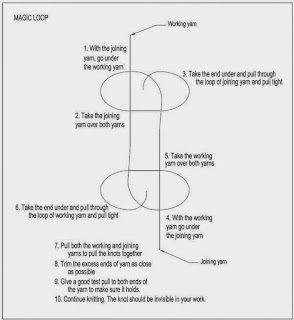Allison was the belle of the ball, wearing her completed Customfit sweater. The sweater is sparkly and magical. This yarn is definitely next up in my customfit queue.
Now she is working on The Age of Brass & Steam Kerchief in Meadowcroft Dyeworks worsted weight yarn.
Cornelia's daughter and granddaughter wearing their ponchos. A very rewarding moment.

With her own poncho at the finisher, she began working on a new swatch for her next Customfit sweater. The yarn is Artyarns Ensemble Light (DK: 50% Cashmere, 50% Silk, 400 yards).
Mallory was ready for the final decrease rounds of the Fool's Fair Isle Baby Hat that she knit with Adriafil Knit Col (DK: 100% Merino, 137 yards). She wanted help transferring onto the double pointed needles now that there were too few stitches for the circular needle.
Progress continues on her Christmas Stocking. We are both looking forward to adorning the packages under the Christmas Tree.
Mary reached the point of grafting (Kitchener stitch) the nose of her Otto Bear. Next we picked up for the neck and began the body. We discussed how to interpret the language of the pattern and how punctuation is part of the directions.
Mary Ellen is loving knitting the All About the Yarn Cowl with Artyarns Big Merino Cloud (Worsted: 80% Merino, 20% Cashmere goat, 219 yards).
Eleanor pinned her Customfit sweater together to sew. She is using her leftover Kid Paillettes to knit the Dangling Conversation.
Carol finished 3 squares for her Anthology Cuffed Shawl Sweater from Knitting Block by Block by Nicky Epstein.
The yarn she's using is Plymouth Select Worsted Merino (Worsted: 100% Merino, 219 yards). I didn't show the third square, it was simply stockinette.
Carol asked me to expound on knots in knitting. She used the phrase, "Don't let your slip show" as a metaphor for "not completing the look" or in our case, not finishing your knitting to it's best potential.
Mary Ellen is loving knitting the All About the Yarn Cowl with Artyarns Big Merino Cloud (Worsted: 80% Merino, 20% Cashmere goat, 219 yards).
Eleanor pinned her Customfit sweater together to sew. She is using her leftover Kid Paillettes to knit the Dangling Conversation.
Carol finished 3 squares for her Anthology Cuffed Shawl Sweater from Knitting Block by Block by Nicky Epstein.
The yarn she's using is Plymouth Select Worsted Merino (Worsted: 100% Merino, 219 yards). I didn't show the third square, it was simply stockinette.
Carol asked me to expound on knots in knitting. She used the phrase, "Don't let your slip show" as a metaphor for "not completing the look" or in our case, not finishing your knitting to it's best potential.
Emphatically, I do not believe in leaving knots in knitting. They are a false sense of security and can ease apart at anytime. There are two separate issues with knots in knitting.
1. Random knots occurring in the yarn. Here is a link to a blog post that explains why they occur.
2. Should you knot your yarn when changing balls?
There are several different ways to go about joining a new ball of yarn (when you're at the tail end of the old ball of yarn, and you need to add in a new ball of the same color). Personally, I choose to do this near the end/beginning of a row. However, if I'm knitting a very textured piece (i.e. cables) I might join mid row and hide the ends in the bulk of the cable cross.
 | |||
| Picture from techknitting.blogspot.com |
1. Overlapping: (Often used mid row) Knit a 3-4 stitches with the new (ball) of yarn together with the old yarn (creating a couple of double stitches). On the next row, knit or purl them together. Downside: it can be a bit lumpy/visible in your knitting. Techknitter adjusts the tension to alleviate that problem.
 |
| Diagram from techknitting.blogspot.com |
2. Felted Join or Spit Splicing: This may sound yucky to some of you, however it is a pretty cool trick. This only works with 100% wool - not merino. You take the tails of the old and new yarns and overlap in your hand, then you wet it (traditionally with spit) and rub the ends together until they become one.
3. Joining at the beginning of a row by knotting the old and new yarns together. Personally I tie a loose knot with the old and new yarns a stitch or two in from the end/beginning of a row with the intention of removing the knot later and weaving it in. In the same blog post from Techknitter, there was a great suggestion of leaving tails long enough for sewing and using the tails for sewing the seams later on.
4. Drop the old yarn and begin knitting with the new yarn: Similar to step 3 minus the knot. Your tension will be a little loose and can be adjusted after a row or two.
 |
| Diagram from knittingparadise.com |
5. Magic knot: I have not tried this, so I'm sharing it without commentary.
In class we discussed the first and third methods. Having delved into this a little further, I might knit a few swatches and test out the techniques....after the holidays.
I would love to hear from about how you join yarn and whether you do it at the end/beginning of a row or wherever your yarn runs out.










No comments:
Post a Comment